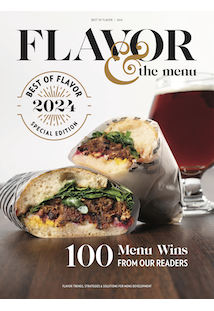


Jason Gronlund
Principal, Executive Chef
Jason Gronlund Consulting
Buttermilk Bissants (Biscuit Croissants) with Boursin® IQF Gournay Cheese Cubes
Recipe courtesy of Jason Gronlund
Sponsor: Bel Brands USA
Servings: 24
Ingredients
Bissants:
- ¼ c sugar
- 3 Tbsp warm water
- 2 tsp active dry yeast
- 28 oz all-purpose flour
- 2 tsp kosher salt
- 1 Tbsp baking soda
- 1 Tbsp baking powder
- 4 oz unsalted butter, cold
- 4 oz vegetable shortening
- 2 c buttermilk
Laminating:
- 2 Tbsp all-purpose flour
- 4 oz vegetable shortening
- 4 oz unsalted butter, cold
- 1 tsp kosher salt
- 6 oz Boursin® Professional Frozen Gournay Cheese Cubes, Garlic & Fine Herbs
Finishing:
- Melted butter, as needed
Directions
For the Bissants:
- In a small bowl, stir together the sugar, warm water and yeast. Let sit aside for 5 minutes to bloom; the mixture will become foamy.
- In a large mixing bowl, add the flour, salt, baking soda and baking powder. Using a whisk or clean gloved hand, blend the dry ingredients.
- Add the shortening and butter. Using a pastry blender or pair of forks, cut through the mixture until crumbly. With clean gloved hands, flatten out the pieces of butter and shortening. Do not overwork or let the pieces soften too much. If they feel like they are very soft, refrigerate the bowl for 20 minutes.
- Add the yeast mixture and buttermilk, stirring with a wooden spoon or clean gloved hand until dry ingredients are moistened and pulled together in a ball; do not overmix.
- Spray a large bowl with cooking spray or coat with butter. Place the dough into the bowl and then grease the top of the dough as well. Cover the bowl with plastic wrap, place it in a warm place, and let it rise until puffy for 2 hours.
For the Laminating:
- In the bowl of a stand mixer fitted with the paddle attachment, beat the flour, butter, shortening and salt at medium speed until creamy, about 4 minutes. This can also be done in a bowl with a piano whip.
- Place a sheet of parchment paper on a quarter sheet pan; if a double batch, use a half sheet pan. Spread the butter mixture into a 10 × 8–in rectangle. Cover it with parchment paper and refrigerate at 40°F/4°C for 30 minutes.
- On a clean work surface or rolling mat, turn out the dough. Roll it into an 8 × 15–in rectangle.
- Place the butter block on the right-hand corner of the dough; this should only cover two-thirds of the dough.
- Evenly spread the IQF Boursin® pieces over the butter. Fold the uncovered dough over the butter like you’re closing a book. Fold the other half up over the top while applying pressure around the surface so it spreads out evenly. You now have 2 layers of shortening and 3 layers of dough. Turn the dough 90 degrees, ensure the surface is lightly dusted with flour, and use a clean lightly floured rolling pin roll out the dough again to the same 8 × 15–in rectangle 1 in thick.
- With a clean brush, remove any excess flour and fold the dough in thirds again like the first time, again pressing evenly so it forms a rectangle.
- Repeat this step at least 5 times. If the butter gets too soft, wrap the dough in plastic wrap and refrigerate for 30 minutes.
- Once the layering is done, refrigerate the laminated dough for 30 minutes to let it relax and solidify shortening.
- Place parchment paper on a half sheet pan. Roll out the dough to 1 in thickness. Evenly mark the dough to get 24 pieces and use a sharp knife to cut out the 24 biscuits. Place them on the prepared pan.
- Bake in a 400°F/200°C oven for 15 minutes, rotate pan, and bake for 10 minutes more. Check color and finish baking until golden brown.
- Remove from oven and place pan on rack. Let stand for 10 minutes and then brush the bissants with melted butter.
- These now can be kept warm or served.
Chef Notes
Make sure you bloom out the yeast so that it is activated correctly. If the yeast is not activated or bad, the bissants will not raise and layer properly.
Make sure the butter, shortening and flour are blended and well chilled again to get the micro layers/laminating done correctly.
It is easy to overmix the base dough when blending the dry and wet ingredients. Ensure that you do not overmix the dough base.
These can be made, frozen and baked directly from frozen at the same 400°F/200°C. Once frozen, they can be bagged and sealed for saving room and baked as needed.
Project Management: Summit F&B
Photography: Carlos Garcia // Food Styling: Peg Blackley & Bree Williams







